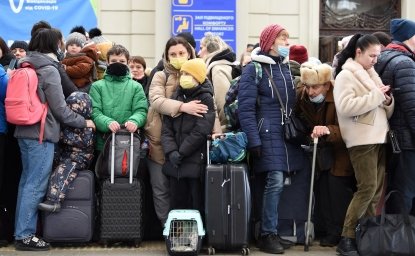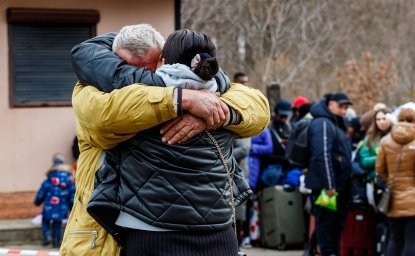A young boy jumped a subway turnstile in New York. He was caught and incarcerated at the Riker’s Island juvenile facility. Another child might have been released to his parents but this boy, an undocumented immigrant, was placed in federal custody.
“Immigration and Customs Enforcement [ICE] was not interested in the type of offense. They want to find non-citizens with a view toward removal,” said Susan Terrio, a Wilson Center fellow on leave from Georgetown where she teaches anthropology and French studies.
Terrio said that ICE works closely with law enforcement in many areas to identify all non-citizen juvenile offenders—even those with nonviolent offenses such as trespassing, graffiti, or truancy—and, if they have no parents or guardians in the United States, transfers them to federal custody.
Once charged, the United States then initiates removal proceedings. When apprehended, these youths are detained in a system of closed shelters that range from group homes to juvenile jails, depending on the level of risk they pose. They remain in federal custody until they can be released to family, foster homes, or returned to their countries of origin.
From 2009 – 2012, Terrio gained access to 19 of the 39 detention facilities for unaccompanied minors where she interviewed attorneys, judges, case managers, staff, directors, and clinicians. Most of these facilities are clustered in states close to the southern border: Texas, Arizona, Florida, and California, to name a few. In addition to on-site visits, Terrio also observed immigration court proceedings and tracked down formerly detained youths to hear their stories.
These unaccompanied minors comprise a vulnerable population. Many of them, disproportionately penalized for non-violent offenses, lack legal representation, and have unmet special needs, all while facing the threat of deportation.
A Scary Ride
Before leaving their homeland, during the journey, and after they arrive, these undocumented juveniles face great risk. Some ride on cargo trains; many are subjected to gang violence en route. They endure abuse by smugglers, are easy prey for traffickers and other exploiters, and experience coercive arrests by border patrol.
“It’s an uphill battle to find their families and to try to obtain legal status given the limits imposed by U.S. immigration law,” said Terrio.
Who are they?
The vast majority come from Central America—Mexico, Guatemala, El Salvador, Honduras. They are young, Spanish-speaking men between 14 and 17 years old. Nearly a fifth are younger than 14.
“Many come here to reunify with their families, although many of their parents are also undocumented,” said Terrio. “They have no adult protection or caregivers in the home country. Many were abandoned, abused; they had their human rights violated; some left their homeland to escape gang recruitment or fled from armed conflict.”
Some are undocumented children apprehended at or near the border; others are children, brought by undocumented parents, who have lived in the States their whole lives and come under the radar of the child welfare system or the juvenile or family courts.
Apprehended
When immigration authorities apprehend an undocumented minor, under federal regulations, they must determine if the juvenile is unaccompanied. If so, the juvenile is placed in the custody of the Office of Refugee Resettlement (ORR), an agency under the Department of Health & Human Services, with considerable experience resettling refugee children. Children are held pending release to approved sponsors.
Terrio said, “The problem is that placing unaccompanied and undocumented minors in federal (ORR) custody ensnares this population in two parallel, but separate, federal systems:
- mandatory detention in custodial facilities
- removal proceedings in immigration courts
There is a tension between the competing agendas that govern these systems.”
The ORR system, she explained, is guided by western child welfare standards that emphasize humanitarianism and protection, with particular attention to trauma, pathology, and vulnerability. This compassionate agenda, she said, “conflicts with the more political and better funded agenda associated with Customs and Border Patrol (CBP), Immigration and Customs Enforcement (ICE), and immigration courts that prioritize enforcement and security and are dominated by discussions of risk and accountability.”
It turns out that only 12 percent of the undocumented juveniles in ORR custody have been charged with, or convicted of, juvenile delinquency or criminal offenses. But their journey to freedom is a difficult one.
Challenges
While in custody, these children face formidable challenges, such as:
- Finding competent pro bono representation; half go to court without attorneys
- Reunifying with undocumented family members in the U.S.
- Identifying viable forms of legal relief
- Being held to the same accountability standards, evidence, and burden of proof as adults under U.S. immigration law. “The current law forbids immigration judges from considering a child’s best interest,” said Terrio.
- Making a successful asylum claim based on one of the five protected grounds: race, religion, nationality, membership in a social group, or political opinion
- Managing the restrictions of detention
- Lack of therapeutic residential facilities for those who need intensive therapy
Before 9/11/01
Under the older Immigration and Naturalization Service, in effect until 2002, undocumented minors were subjected to adult-like detention and many were held alongside htose who committed violent offenses. Some juveniles would languish in detention for years. Since 1999, when approximately 2,000 minors were detained annually, the numbers apprehended and held in federal custody have spiked.
Since 9/11/01
Some positive changes began to take root since 2002 when the Office of Refugee Resettlement assumed responsibility for these minors.
Federal regulations now mandate the least restrictive setting and limited stays in detention, while 2008 legislation has enhanced due process protections. Placement options now often consider best interest and some of these minors are getting placed in foster care or group homes. And, under ORR jurisdiction, detention periods have shortened. Terrio said, “The goal now is to protect them and stop the potential for additional risks.”
The French Case
Terrio came to this research after studying the French criminal system. Between 2000 – 2005, Terrio researched the treatment and representation of juvenile delinquents in the largest, and most influential, French juvenile court in Paris.
One chapter in her 2009 book, Judging Mohammed: Juvenile Delinquency, Immigration and Exclusion at the Paris Palace of Justice (Stanford University Press), focuses on separated and unaccompanied minors from East Europe, and North and West Africa, who came to France in search of refuge, education, and work opportunities. Without the opportunity to work legally or attend school, many resorted to shoplifting or stealing proceeds from a parking meter. These petty offenses would land them in juvenile court.
“These kids were disproportionately penalized,” said Terrio. “Instead of childhood protections, they received harsh punitive treatment.”
The French case inspired Terrio to begin research on the identification and treatment of undocumented and unaccompanied minors who migrate to the United States for the same reasons.
Terrio’s forthcoming book, Whose Child am I?, will include a range of personal stories that focus on the experience of detention from the perspective of the staff who run the facilities, the judges who preside over removal proceedings, and the young people who were detained. These youth recount their lives after release and share their dreams for the future.
Terrio said, “Many of them agreed to talk, if possible, to help improve the system in any way they could.” The book will open a window on a system that is largely unknown to the general public and costs taxpayers millions of dollars each year.




